Marrakech, the Red City, is known for its unique charm and the diverse tourist attractions it offers to its visitors. Historical and religious landmarks form an essential part of this charm, but Marrakech also embraces lush gardens and vibrant souks that deserve exploration. In this comprehensive guide, we will take you on a tour to discover the most prominent historical and religious landmarks and other outstanding tourist places that must be visited in Marrakech, such as Jemaa el-Fna Square, Bahia Palace, Ben Youssef Madrasa, Majorelle Gardens, Marrakech Souk, and others.
Historical Landmarks and Ancient Palaces in Marrakech
Marrakech’s palaces, madrasas, and historical walls tell chapters of the city’s rich history, offering wonderful examples of traditional Moroccan and Islamic architecture. These historical monuments are not just old buildings, but witnesses to the greatness of Moroccan civilization throughout the ages.
Bahia Palace
Bahia Palace is one of the most beautiful historical landmarks in Marrakech, built in the late 19th century to be the residence of vizier Ahmed ben Moussa. The palace is distinguished by its stunning design that embodies the splendor of Moroccan architecture with its open courtyards, interior gardens (riads), and exquisite decorations of zellige (mosaic tilework), wood carvings, and stucco.
The palace extends over an area of eight hectares and includes 150 rooms decorated with the finest carvings and paintings, making it a living museum of Moroccan architectural art. The interior gardens add a touch of tranquility and beauty, reflecting the philosophy of Islamic architecture in the harmony between nature and building.
Practical information: The palace is located in the Kasbah district in the old medina and is open from 9 am to 5 pm daily. Entrance fees are reasonable (about 70 Moroccan dirhams), and photography is allowed inside the palace.
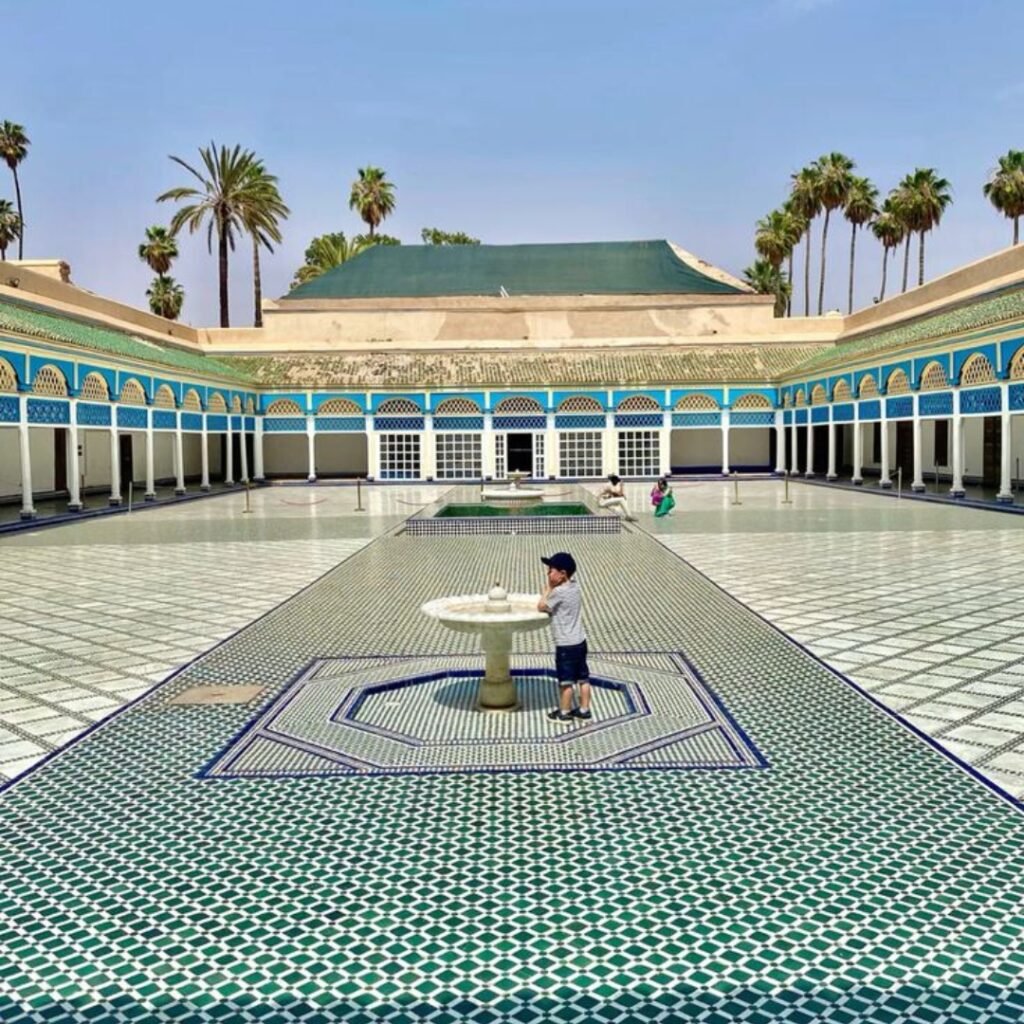
El Badi Palace (The Incomparable Palace)
El Badi Palace was built in the late 16th century by Sultan Ahmed al-Mansour of the Saadian dynasty to be a ceremonial palace reflecting the power and wealth of Morocco at that time. Although the palace is now in ruins, it still testifies to its past grandeur through its vast expanse, sunken gardens, water pools, and remaining walls.
The palace is distinguished by its unique design that the sultan was inspired by from the Alhambra in Granada, and visitors today can explore the vast courtyards and remaining wings and enjoy watching the storks that often build their nests on the high walls of the palace.
Practical information: The palace is located near the medina, a short distance from Bahia Palace. It is open from 9 am to 5 pm, and entrance fees are about 60 Moroccan dirhams.
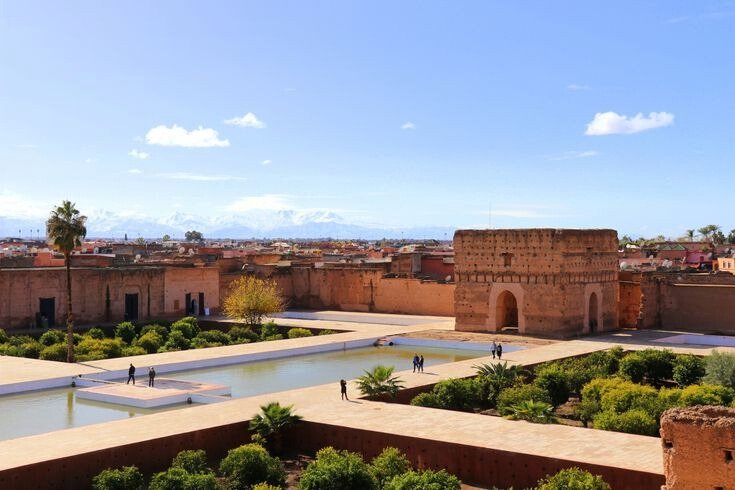
Ben Youssef Madrasa
Ben Youssef Madrasa was founded earlier but rebuilt in the 16th century to become one of the largest Islamic schools in North Africa. The school was an important center of Islamic education, where students studied religious sciences, language, philosophy, and mathematics.
The school is characterized by its magnificent Marinid and Saadian architecture, especially the large courtyard adorned with colorful zellige and intricate plaster carvings, the small rooms that housed students, and the beautifully decorated prayer hall. Ben Youssef Madrasa is today one of the most important historical and religious landmarks in Marrakech and a unique model of Islamic educational architecture.
Practical information: The school is located near Ben Youssef Mosque and the souks of the medina and is open from 9 am to 6 pm, with entrance fees of about 70 Moroccan dirhams.
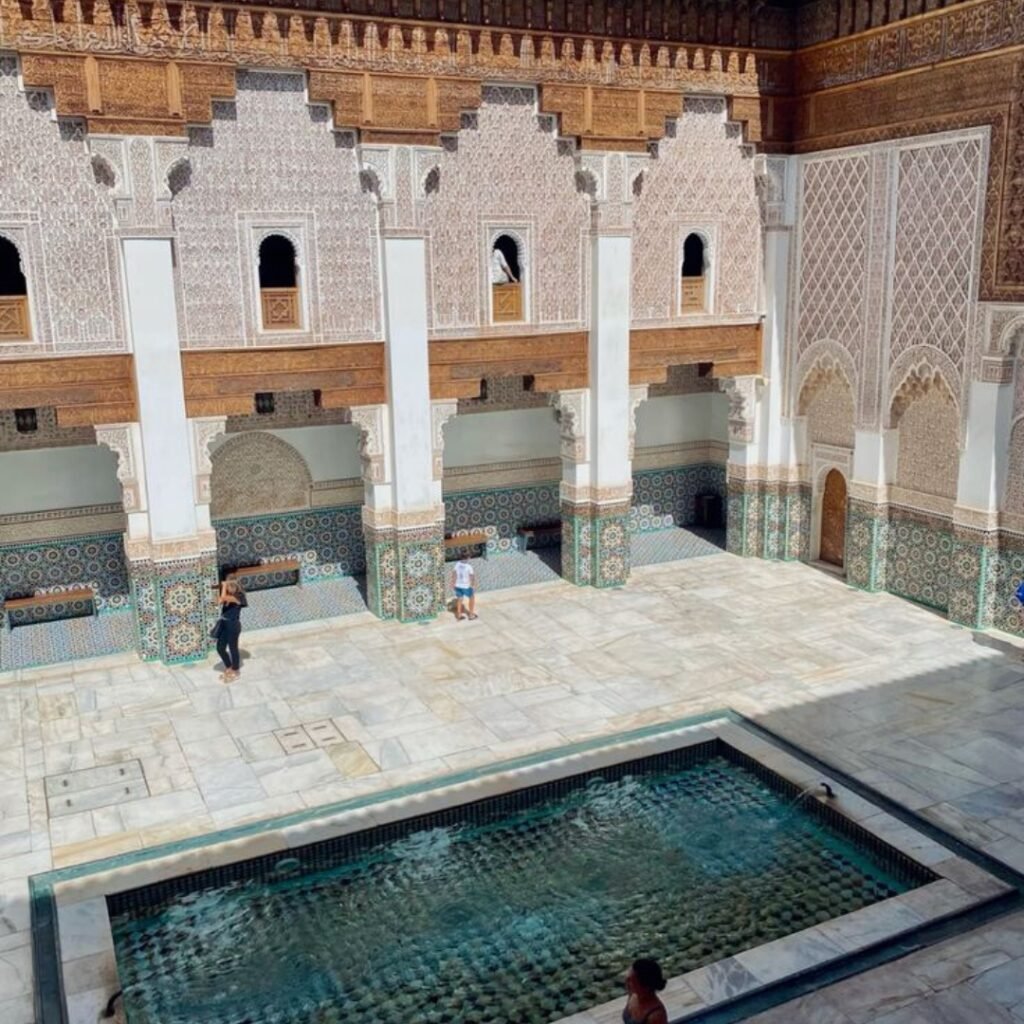
The Historical Wall and City Gates
The old city of Marrakech is surrounded by long, ochre-colored walls, dating mostly from the Almoravid and Almohad periods. These walls are about 19 kilometers long and 9 meters high, and include several important historical gates, including:
- Bab Agnaou: One of the most beautiful gates in Marrakech, built during the Almohad period, and distinguished by its fine stone carvings.
- Bab Doukkala: An important gate that connected the city to the Doukkala trade route.
- Bab Aghmat: Named after the ancient city of Aghmat, and was an important trade route.
- Bab El Khemis: Located in the northern part of the city, and was linked to the El Khemis souk.
Practical information: Visitors can walk along the walls and enjoy viewing the different gates as entry points to the old city. Viewing the ramparts and gates is free from the outside.
Jemaa el-Fna Square: The Pulsing Heart of Marrakech
Jemaa el-Fna Square is not just a square, but an open theater for Marrakech’s history, culture, and daily life, and a UNESCO World Heritage site. This square is considered one of the most famous tourist places not only in Marrakech but in all of Morocco.
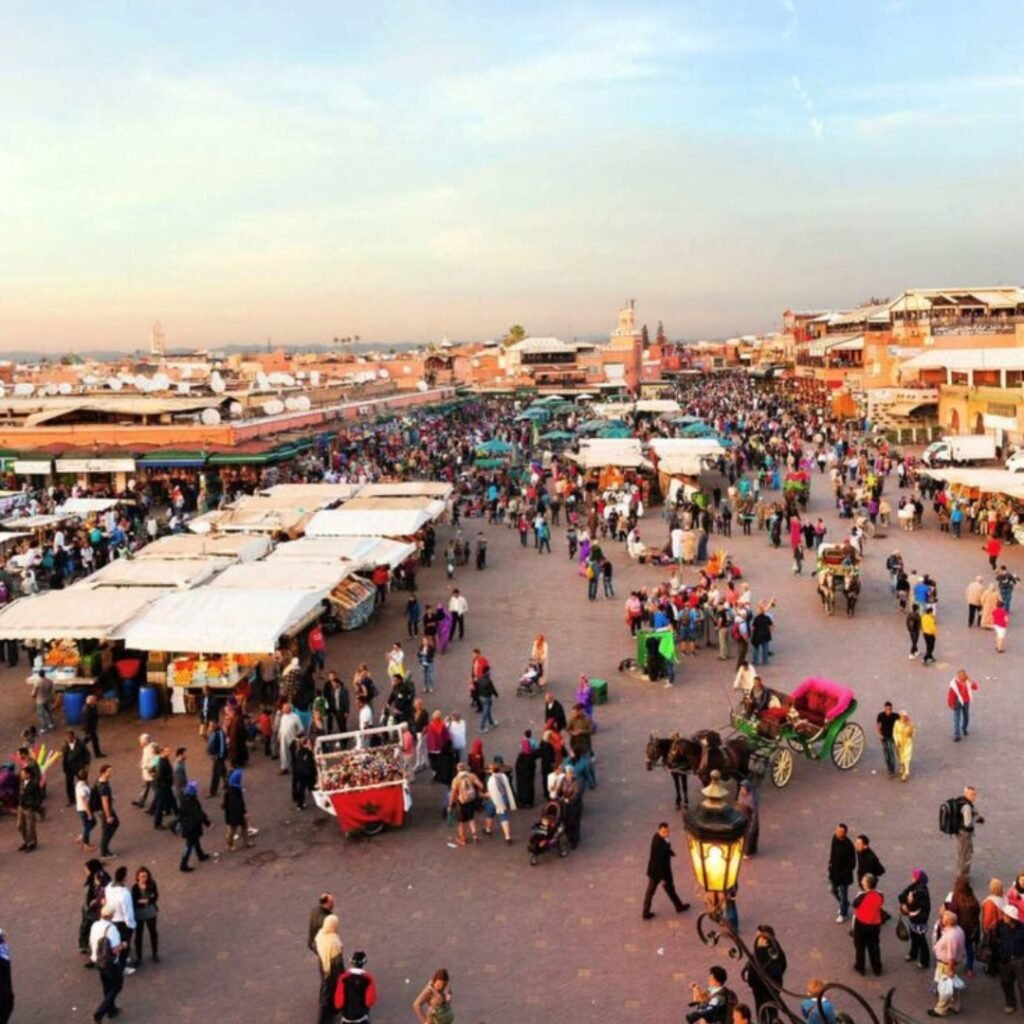
The Atmosphere of Jemaa el-Fna Square: Day Charm and Night Rhythm
Jemaa el-Fna Square undergoes a notable transformation from day to night. During the day, the square is filled with snake charmers, storytellers, and fresh juice stalls. Visitors can watch traditional performances, listen to Berber music, and enjoy the city’s vibrant atmosphere.
As night falls, the square transforms into a real festival of lights, smells, and sounds. Mobile food stalls appear, offering different types of traditional Moroccan cuisine, artistic and musical performances increase, and the square fills with local visitors and tourists from around the world.
The Cultural and Historical Significance of the Square
Jemaa el-Fna Square represents a historical meeting point and an important commercial center in Marrakech since the founding of the city. The square has witnessed various historical events that the city has experienced and has developed to become a center of Moroccan popular culture and traditional street arts.
UNESCO has recognized the importance of Jemaa el-Fna Square as a center of intangible cultural heritage, where ancient traditions and popular arts such as storytelling, musical heritage, and folk dances are preserved.
Practical information: The square is easily accessible from anywhere in the old city. For a better view, it is recommended to visit cafes and restaurants with terraces overlooking the square, especially at sunset. Be careful of crowds and stay vigilant for your personal belongings.
Religious Monuments and Sufi Zawiyas in Marrakech
Marrakech houses many religious monuments that reflect its spiritual status, from grand mosques to historic Sufi zawiyas. These religious monuments represent an important part of the city’s identity and culture.
Sufi Zawiyas and Their Spiritual Importance
Sufi zawiyas are religious complexes comprising a mosque and sometimes a mausoleum of a saint or Sufi sheikh, as well as places for teaching and worship. These zawiyas played an important role in the religious and social life of Marrakech throughout history and were centers of religious education and the spread of Sufi thought.
There are several important Sufi zawiyas in Marrakech, including the Qadiriya Zawiya which belongs to the Qadiriya Sufi order. The city is also known for the zawiyas of the “Seven Saints,” the most important of which is that of Sidi Bel Abbès, which is one of the most important religious sites in the city.
Important practical note: Please note that entry to zawiyas is often restricted to Muslims. Non-Muslims can content themselves with observing the exterior architecture of these historical buildings.
Koutoubia Mosque
Although not included in the original list, one cannot talk about religious monuments in Marrakech without mentioning the Koutoubia Mosque, the largest and most famous mosque in the city. The mosque was built during the Almohad period in the 12th century and is distinguished by its imposing minaret which reaches 77 meters in height and has become a symbol of the city.
The Koutoubia minaret is a magnificent example of Almohad architecture and has inspired the design of many other minarets in the Islamic world, including the Hassan Tower in Rabat and the Giralda in Seville.
Practical note: Entry to the mosque is restricted to Muslims. Non-Muslims can stroll through the surrounding gardens and admire the impressive exterior architecture of the building.
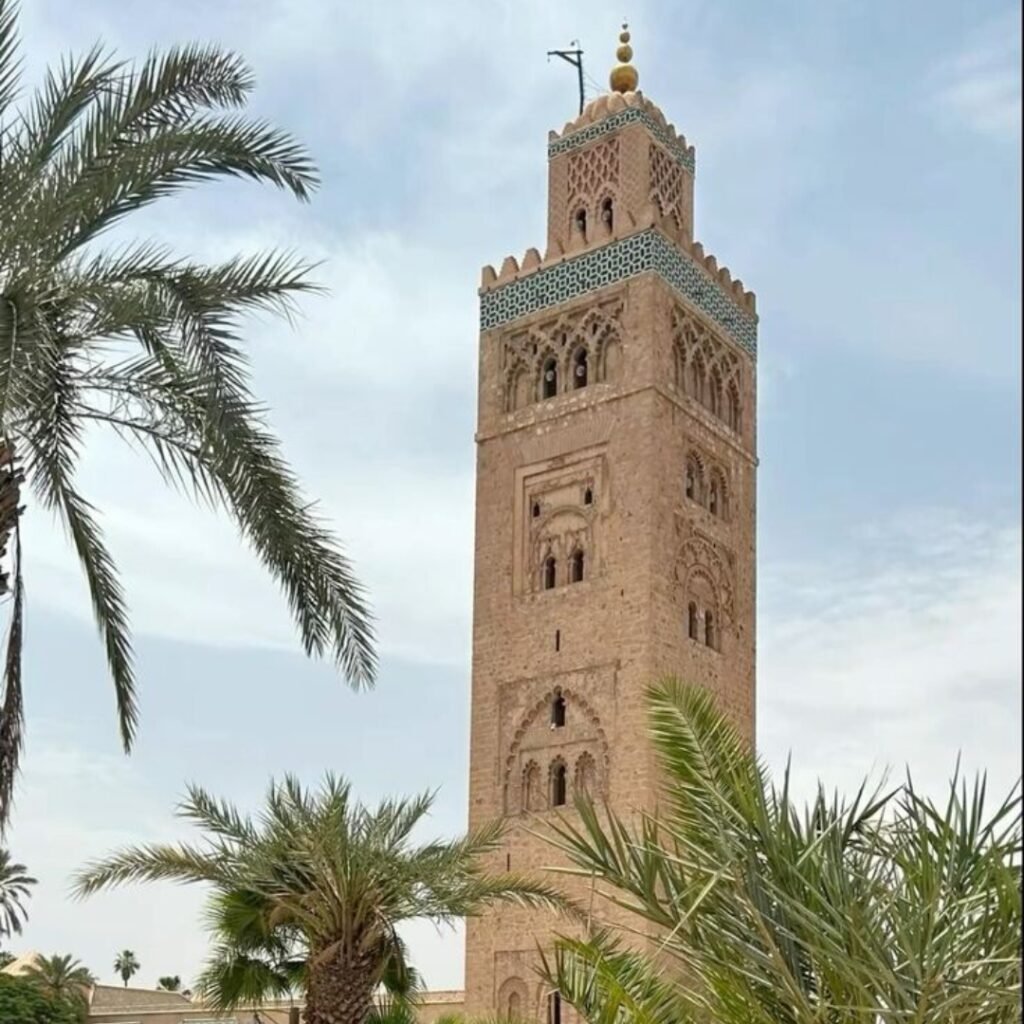
The Gardens of Marrakech: Oases of Calm and Beauty
Away from the hustle and bustle of the city, Marrakech’s gardens offer a peaceful refuge and wonderful green spaces to relax and meditate. These gardens reflect the diversity of cultures that have passed through the city, from traditional Islamic designs to modern French and European touches.
Majorelle Gardens
Designed by French painter Jacques Majorelle in the 1930s, then purchased by French designer Yves Saint Laurent and Pierre Bergé in the 1970s who revitalized them. The gardens are distinguished by their characteristic cobalt blue color (Majorelle blue) which adorns buildings and pools, and rare tropical plants from around the world.
The gardens also house a small Berber museum that displays a collection of traditional artifacts from Amazigh culture. Majorelle Gardens are today one of the most visited tourist sites in Marrakech and a source of inspiration for many designers and artists.
Practical information: The gardens are located outside the old city, in the new city. They are open from 8 am to 5:30 pm, with separate entrance fees for the garden and museum. Due to their great popularity, it is advised to visit them early in the morning to avoid crowds.
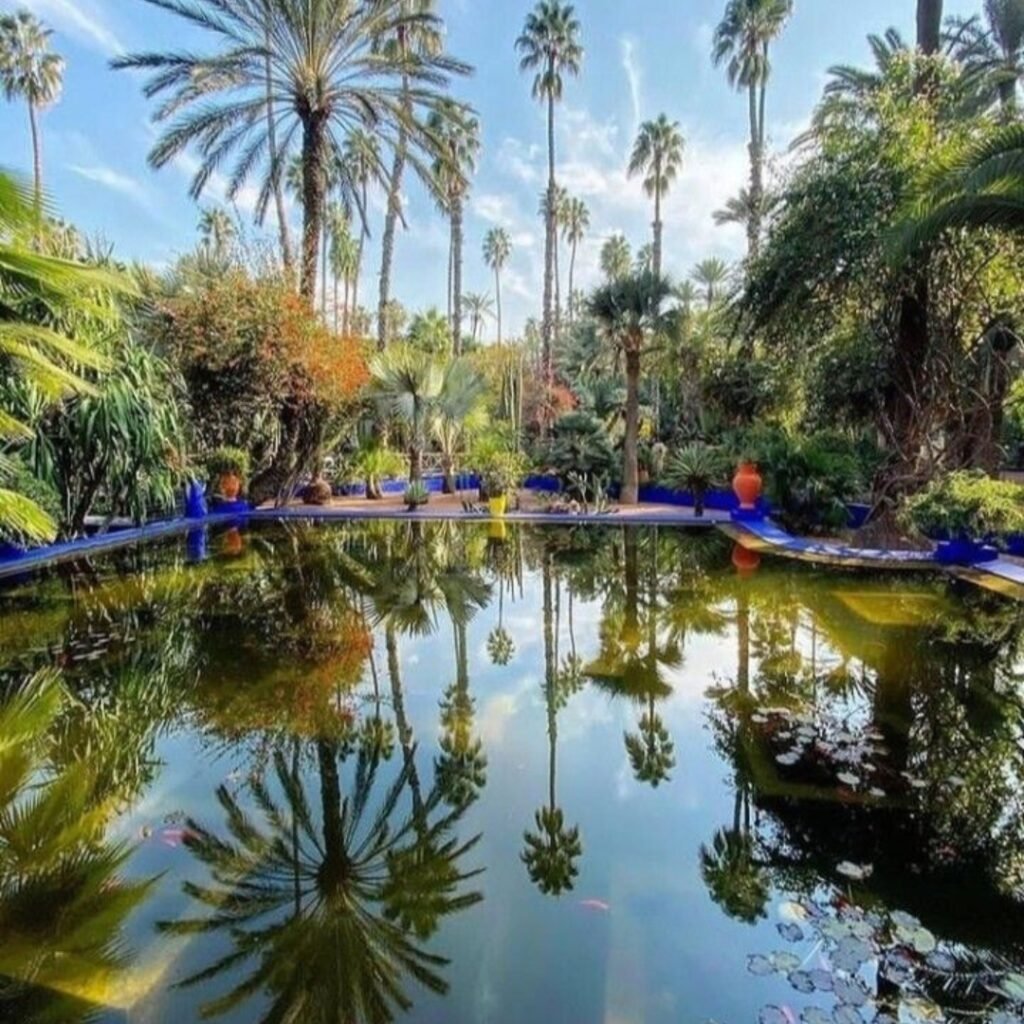
Menara Gardens
The Menara Gardens date back to the Almohad period in the 12th century and are among the oldest gardens in Marrakech. They are characterized by a large water basin that reflects the image of the surrounding mountains, and a traditional pavilion dating back to the 19th century. The basin is surrounded by extensive olive groves that are still productive today.
The gardens were once used as an irrigation reservoir and as an agricultural area, in addition to being a place for strolling and relaxation for sultans and their court. The Menara Gardens today offer a spectacular view of the Atlas Mountains on clear days and are an ideal destination to escape the heat of the city.
Practical information: The gardens are located southwest of the old city and are easily accessible by taxi. Entry is free for most areas of the garden, with nominal fees for entering the pavilion. The Menara is an ideal destination for taking souvenir photos with the pavilion and the Atlas Mountains in the background.
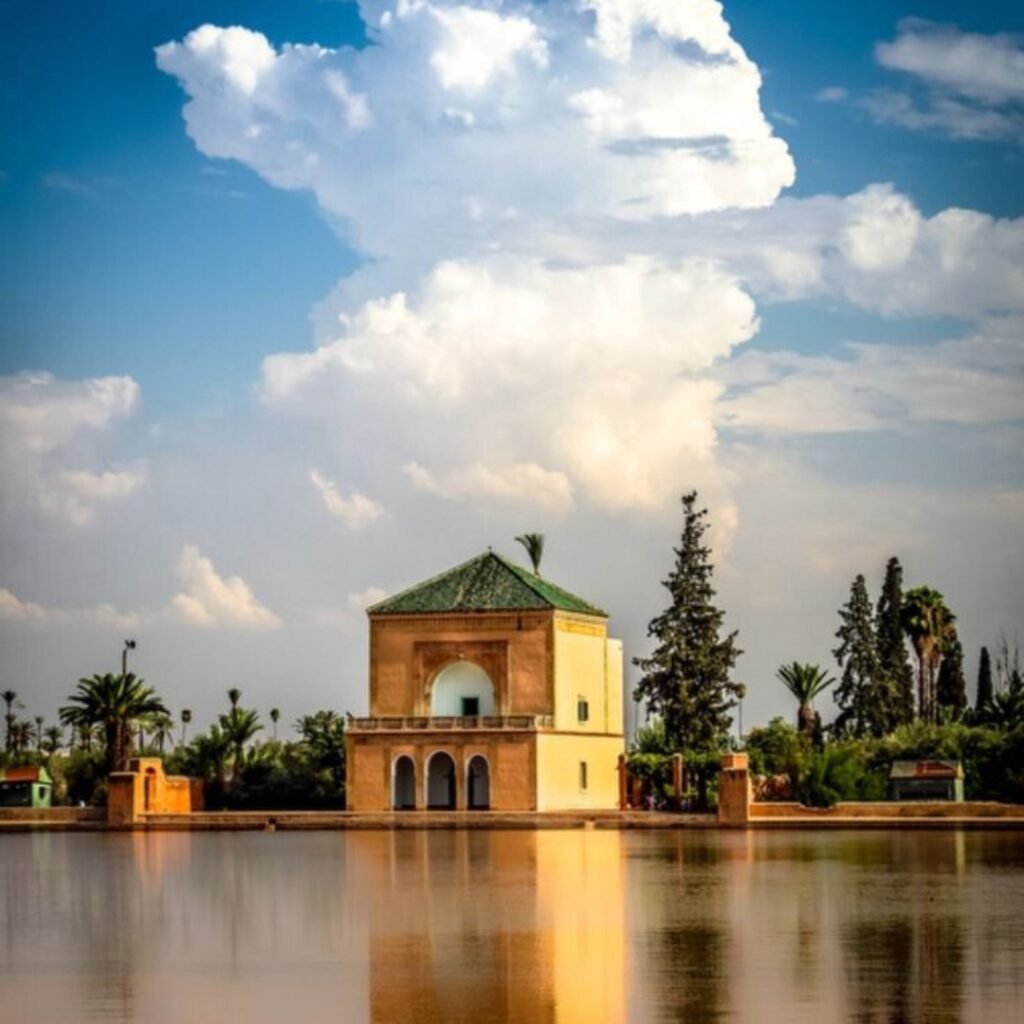
Marrakech Souk: A World of Traditional Commerce
Marrakech Souk is one of the largest and most famous traditional markets in Morocco, and a real labyrinth of crafts, goods, and unique atmospheres. Visiting the souks is an essential experience for understanding the culture and daily life in the city.
Location and Layout of the Souk
The souks of Marrakech are located directly north of Jemaa el-Fna Square, forming a vast and complex network of covered alleys that extend for kilometers. The souks are divided into specialized areas, where craftsmen and merchants gather according to the type of merchandise they sell.
This traditional organization of Moroccan markets makes it easier for visitors to find what they are looking for, although walking through the intertwined alleys may seem confusing at first. These souks constitute the heart of the economic life of the old city and reflect Marrakech’s history as an important commercial center.
You will find in Marrakech Souk a wide range of traditional Moroccan products, including:
- Leather products such as bags, shoes, and wallets
- Traditional textiles and authentic Moroccan carpets
- Pottery and colorful ceramics
- Brass and metal crafts
- Spices, herbs, and aromatic oils
- Traditional lamps made of brass and colored glass
- Traditional clothing such as djellabas and caftans
- Wood carvings and handicrafts
- Silver jewelry and traditional ornaments
- Souvenirs of all kinds
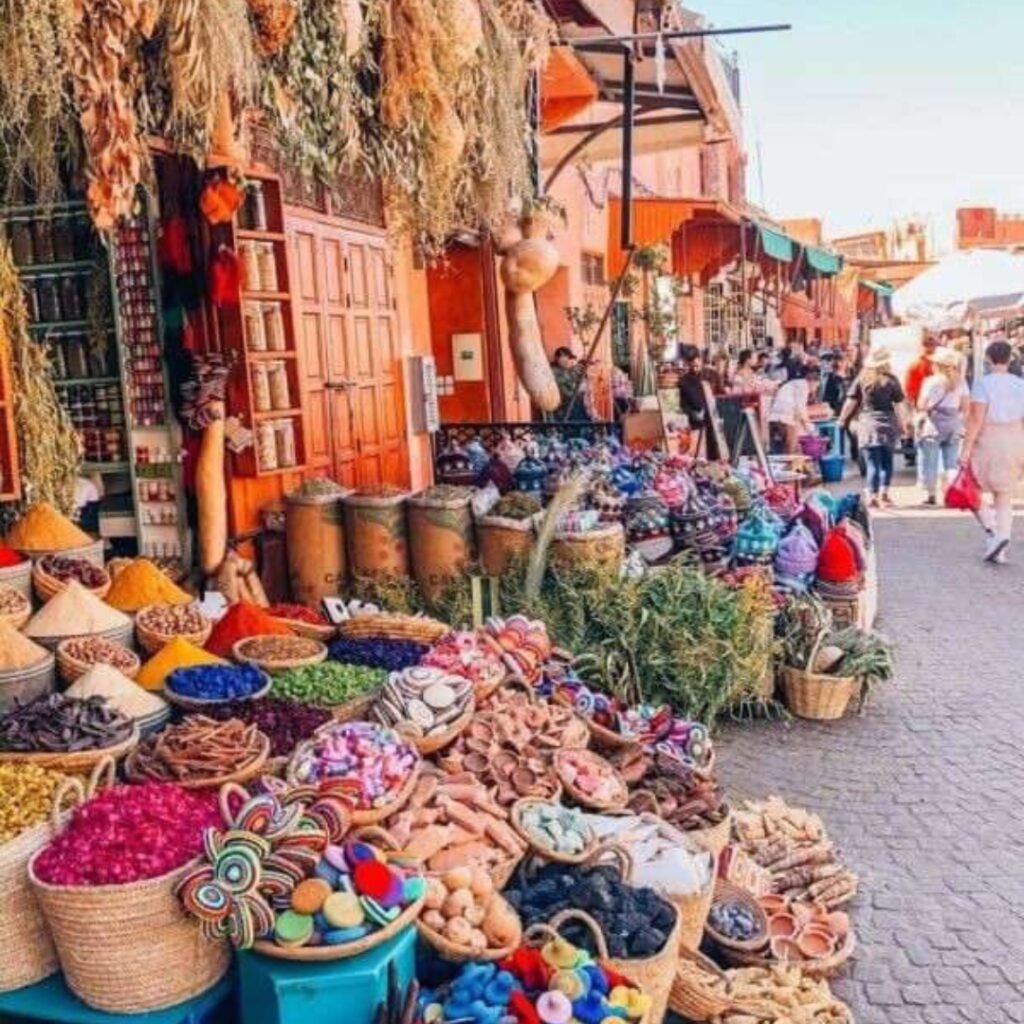
Shopping Atmosphere and Bargaining
Visiting Marrakech Souk is a complete sensory experience: vibrant colors fill the eyes, smells of spices and incense fill the nose, and sounds of vendors and craftsmen at work fill the ears. Interaction with merchants is an essential part of the shopping experience, and bargaining (negotiation on price) is a well-established tradition.
To bargain politely and effectively, it is advised to follow these tips:
- Start by asking the price without showing too much interest in the product
- Propose a price 50-60% lower than the asked price
- Be prepared to walk away if the price doesn’t suit you
- Keep smiling and polite during the negotiation process
- Generally settle on a price halfway between your first offer and the initial price
Practical Information for Visiting the Main Monuments and Tourist Places in Marrakech
To make your visit to this diverse group of historical and religious landmarks and tourist places in Marrakech enjoyable and smooth, here are some general tips:
Getting around the city: Walking is the best option for exploring the old city, being careful of motorcycles and bicycles. Use paper maps or map applications that work offline. Small taxis (petit taxi) are appropriate for short distances in the city, and horse-drawn carriages (calèche) are a pleasant touristic way to move around the old city.
Best time to visit: Spring and autumn are the most appropriate climatically, with moderate temperatures. Early morning is the best time to visit historical monuments to avoid crowds, while it is preferable to visit Jemaa el-Fna Square in the evening to experience its lively atmosphere.
Etiquette: Make sure to wear modest clothing that covers shoulders and knees, especially when visiting religious sites. Always ask permission before taking photos of people, and respect local traditions in bargaining and other interactions.
Tickets and fees: Most major historical sites and gardens require entrance fees, while squares (like Jemaa el-Fna) and general strolling in the souks are free. Check current prices before your visit as they may change.
Guides: You can use a licensed local tour guide, especially for navigating the medina and souks or for getting historical context. Local guides offer valuable insights and help avoid getting lost in the city’s intertwined alleys.
Conclusion: Exploring the Historical, Religious, and Cultural Treasures of Marrakech
Marrakech offers a true wealth of diverse historical and religious landmarks and tourist sites that reflect its ancient history and rich culture. From sumptuous palaces to magnificent gardens, from lively squares to traditional markets, the Red City offers a unique tourist experience that combines authenticity and cultural diversity.
Visiting these monuments together gives the tourist a deep understanding of the spirit of the city and its evolution through the ages, from the Almoravid and Almohad states to the modern era. Whether you are a lover of history and architecture, gardens and nature, or shopping and nightlife, you will find in Marrakech what matches your interests.
We hope that this guide will help you plan your visit to the main historical and religious landmarks and tourist sites in Marrakech. Share your experiences after your visit, and enjoy discovering the charm of the Red City with all its beauty, authenticity, and antiquity.


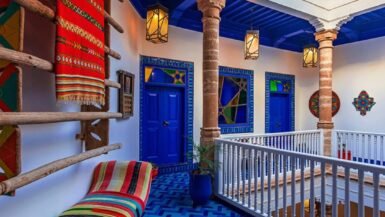


Leave a reply